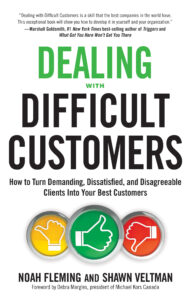Dealing With Difficult Customers
It’s not easy running a business today. A single customer complaint, handled improperly, can send your business into a tailspin. At the same time, if you respond to every single customer complaint, you end up wasting time and money chasing an unsolvable problem.
Enter Noah Fleming and Shawn Veltman, who have written a new book, Dealing with Difficult Customers: How to Turn Demanding, Dissatisfied, and Disagreeable Clients Into Your Best Customers. I recently had the opportunity to talk with them about their work in dealing with customers.
When the Customer Is Blatantly Wrong
You say that, “The customer is not always right. In fact, the customer is often blatantly wrong.” Share your perspective on this. How did “the customer is always right” develop and where did it go wrong?
All of your readers will have their own favorite “unreasonable or crazy customer stories.” In our experience, after complaining about accountants and management, it’s in most salespeople’s top five favorite cocktail party conversation topics.
We start our book with a list of completely clueless, hilarious, and real customer complaints.
Our favorites are:
- “I think it should be explained in the brochure that the local convenience store does not sell proper biscuits, like custard creams or ginger nuts.”
- “Although the brochure said there was a ‘fully equipped kitchen,’ there was no egg slicer in the drawers.”
- “We went on holiday to Spain and had a problem with the taxi drivers, as they were all Spanish.”
Funny when you read them, but scary when you hear that these are 100% real complaints left by real customers. Is the customer right to be upset that the local store doesn’t sell proper biscuits like custard creams or ginger nuts? Or a customer who complains of too many Spanish people in Spain? Of course not. In these examples, the customers are blatantly nuts.
This idea that “the customer is always right” is one of those things that’s easy for management to tell their frontline employees; it sounds good in practice, and it leads to tremendous wasted time, effort, and often burnout. Because, sometimes, you really do have to fire customers – one of the things we talk about at length in the book. Telling your people that the customer is always right is asking them to close their eyes to reality, and when you ask them to do that, it hurts your ability to ask them to do anything else. After all, with some of the complaints above, how could those customers be right? What does it mean to treat the customer as if they’re right?
One of the sections in the book is about how to distinguish between valid and invalid customer complaints, and it gives strategies for dealing with both. Even with invalid complaints, you can certainly empathize with the customer’s disappointment and discontent, but if you mistake an invalid complaint for a valid one, you’re not only going to waste time, effort, energy, and money, you’ll also be training your customers to be unreasonable—and training your people to accept that. And of course, the irony is that it’s usually the least profitable customers who are the biggest problems.
Use the Hierarchy of Horrors
What is the hierarchy of horrors and how can leaders use it to improve the customer experience?
One of the founding officers at FedEx, Michael Basch, suggested that one of the key components of FedEx’s success was with the development of a concept he called The Hierarchy of Horrors.
It’s one of the most brilliant business improvement processes ever used. It’s so good, we use it with practically every one of our clients and see fantastic improvements.
FedEx executives created a list of the eight WORST things that the company could screw up for their customers. For example: Missed pickups, damaged packages, lost packages, wrong delivery date/address, etc.
Each of those eight key areas was measured for a short while. For example, each time a package was lost or they missed a pickup, they ticked a box. If a customer called because a package was damaged, they ticked another box.
Then they simply added everything up and ranked the eight key areas in numerical order. FedEx then systematically worked from their highest priority concerns to their lowest.
Now, here’s the best part – employees became more accountable. There was now a number that essentially, and more often than not, pointed towards very specific areas of the company (delivery drivers or warehouse package handlers, for example). Every employee had to significantly improve quality of service and work together to reduce the horrors.
This was the FedEx game changer.
When to Fire a Customer
When should you fire a customer?
There are two situations that arise that make it mandatory to fire customers. The first is a no-brainer: when customers are being abusive to your staff. This is obviously the right thing to do from a moral point of view, but it’s usually also the financially sound thing to do – the cost of losing that customer is often far less than the benefit of having your employees believe everything you say about your company culture. Even Zappos, who is often hailed as an ultimate when it comes to customer service, will get rid of any customer who is racist, sexist, or vulgar to one of its employees. Too often, there is a huge gap between “what’s written on the walls” and “what happens in the halls.” When this is the case, the resulting trust gap makes it much harder to get the best out of your people, which makes it hard to create great experiences for your clients.
The second category of customers that you need to fire is the ones who consistently create time and monetary stresses on your company. An example we use in the book is of a catalog sales company that was losing millions of dollars per year because a very small percentage of its clients were addicted to ordering and returning items (where the company paid for shipping both ways). These customers either needed to be rehabilitated to shop more responsibly, or to be fired – doing so had a tremendous positive impact on the company.
What behaviors turn great customers into critics?
Plain and simple – a lack of consistency.
In the mad rush for businesses to go from good to great, we often forget that it’s better to simply be consistently good. Loyal customers will brush off the odd mistake as an anomaly, but the more it happens and the more inconsistent you are, the more likely you are to move that customer from the loyal, happy camp to the dissatisfied camp.
 Consistency and meeting expectations matters. We are routinely teaching our clients to mind the expectations gap – the gap between what the customer thinks they’re getting and what they actually get. Your best customers would rather have a good experience 99% of the time than an amazing one 50% of the time and the other 50% being not so great.
Consistency and meeting expectations matters. We are routinely teaching our clients to mind the expectations gap – the gap between what the customer thinks they’re getting and what they actually get. Your best customers would rather have a good experience 99% of the time than an amazing one 50% of the time and the other 50% being not so great.
One thing that most people don’t realize is that it’s not what you actually offer, or what actually happens, that causes customers to be angry – it’s how far that reality is from their own expectation. Consider an example we use in the book: Imagine that you go to McDonalds, and you wait a while for the food. The cashier is disinterested, and the fries are somewhat cold. Do you feel angry at McDonalds? Do you go onto Yelp and try to take them down?
Now imagine you’re at a $600/plate restaurant for your 25th wedding anniversary. Everything is perfect …. except for one thing. Neither you nor your spouse can put your finger on it, but you definitely sense that the waiter is condescending to both of you. It’s bad enough that it’s the first thing you both say as you walk out of the restaurant.
The atmosphere was objectively better than McDonalds. The food was incomparably better than McDonalds. And you are far more disappointed with the experience. The further you drift from the expectations your clients have, the less it matters how good most of what you offer is.
Dealing with angry customers is a topic that we’re all interested in. What steps do you recommend?
The first step we recommend is to find the nearest mirror and take a long, hard look into it. One of the key messages of the book is that more often than not, companies create their own dissatisfied customers based on the policies and structure of the company, rather than just managing to attract only angry people.
Practically speaking, do you know what the top five complaints are from your customers over the past quarter? Have you trained your staff to be able to appropriately answer each of these five complaints, with language that embodies your company culture and values?
Have you role-played these scenarios to make sure that everybody who is customer facing is comfortable using them in the wild? Have you solicited feedback from the frontline staff to see how the answers are working in the wild?
If not (and don’t worry, you’re not alone), those are some good steps to start with!
How do leaders best develop a culture of delivering extraordinary customer experience?
One of the things that we often hear from clients is that our message can be a bit of a downer – after all, in many cases we’re saying, “Guys, we’re not going to give you snappy comebacks to stupid customers. To create great customer experiences, you have to understand that most of the causes for dissatisfaction that your customers are facing are your own fault!” That’s the big twist in the book because that’s not really evident until you start reading it. 101 ways to deal with every unhappy customer is kind of like the fad-of-the-month diet – it works for a while; you lose a few pounds, but it’s not sustainable.
Developing a culture around great customer service needs to be something that senior executives take seriously, and something that they commit to. It’s not enough to roll out a training program and hope that everybody under you does well. And that can be a jarring message. Nobody likes to feel blamed. But one of the wonderful things about this message is that it is inherently positive – it means that companies can indeed change, going from wherever they are today to providing great customer service.

The most important elements are commitments from senior management to pay attention to what’s actually happening within the company and with customers. Secret shop the business. Try to call yourself as if you’re a customer. Role play. Create an environment that rewards practicing the skills of customer service. Invest in tools that make it easy to track customer issues and the resolutions to those issues. Invest in tools that make it easy to coordinate training and store lessons learned. Ensure that senior management is actively using these tools. These are all ways that companies can create a culture of delivering consistently great experiences – and we’ll say again, consistency is more important than a handful of amazing WOW experiences!

What qualities should you look for if you’re hiring for someone dealing with customers?
The obvious answer is that you want somebody personable and friendly. The more useful answer is that you need to hire someone who can follow the processes and procedures you’ve put into place. Someone who is amenable to your script book, and somebody who is enthusiastic in participating in your regular training.

